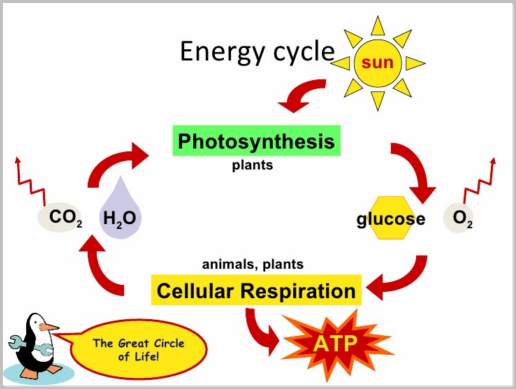The energy needed for survival is furnished to plants and animals through various chemical processes; the sunlight provides much of the energy these living organisms rely on for nourishment. Cells are also dependent upon energy; cells need energy to function properly. Plants need energy to grow and to reproduce; energy is one of the main resources of all living organisms. Cellular respiration ensures that living organisms receive enough energy to sustain life. Pruitt & Underwood (2006) explains, “Cellular respiration is the name given to the metabolic pathways in which cells harvest the energy from the metabolism of food molecules.” (p. 289). Food provides the nutrients living organisms need to stay healthy and for maturity elements.

How Does Cellular Respiration Yield ATP?
Cellular respiration yields adenosine triphosphate (ATP) through various metabolic stages; as each phase occurs, molecules of ATP are formed to provide a much needed source of energy. Cellular respiration occurs in three stages; glycolysis, the krebs cycle, and the electron transport system. Pruitt & Underwood (2006) reports, “Glucose breakdown occurs within cells as a continuous sequence of sequence of 25 steps.” “…when we look at this continuous process carefully, it is apparent that these steps can be grouped into three separate stages,” “We call these stages glycolysis, the krebs cycle, and the electron transport system, also known as the electron transport train.” (p. 289).
Glycolysis takes place in the cytoplasm; this is the first stage of cellular respiration it goes through ten steps to produce ATP for living organisms. Pruitt & Underwood (2006) informs, “In glycolysis, (which means “sugar splitting”), the six-carbon sugar, glucose, is split in half to make two three-carbon compounds, and hydrogens are stripped from carbons.” “The energy of the broken bonds is captured, and there is a net yield of ATP. (p. 289). Four molecules of ATP are formed in glycolysis, but only two molecules of ATP are present once the glycolysis process is completed. The krebs cycle is essential to the production of more ATP. Pruitt & Underwood (2006) repots, “For the Krebs cycle…First, chemical energy entered the pathway in the form of acetyl CoA, and second, chemical energy left the Krebs cycle in the form of ATP, NADH, and FADH2.” (p. 293). Thus, the krebs cycle has set the stage for the final stage of cellular respiration; the electron transport system.
According to “Bioinquiry”, in the electron transport system, ATP is made using energy from a proton gradient; every aspect of this process is linked to the continual working of molecules within the mitochondrion. Pruitt & Underwood (2006) explains, “The energy of electron transport moves protons from the inside of the mitochondrion to the space between the two mitochondrial membranes forming a steep proton gradient.” “It is here in the mitochondrial membrane, that the big ATP payoff from cellular respiration is realized.” (p. 296). Pruitt and Underwood say that 36 molecules of ATP can be formed throughout this particular process.
Where do you Expect Mitochondria to be Present the Most?
I expect mitochondria to be present more in muscle cells rather than skin cells; muscles cells need more energy to perform their daily functions. Muscle cells use ATP to produce kinetic energy which is essential to how long an individual can remain physically active. Mitochondria is a main contributor of energy, therefore, where energy is needed the most, this is where a larger amount of mitochondria tends to exist. Skin cells do not require as much energy as muscle cells require; they usually can serve their purpose in a less complex way. Evans (2009) informs, “Mitochondria are found in all of our cells, but are especially abundant in metabolically active cells, such as brain skeletal muscle, heart liver and kidney.” “These cells can contain thousands of mitochondria, which can comprise about 40% of the cytoplasm.” “In contrast, blood cells and skin cells (epithelial cells) have few if any mitochondria.” (p. 10). For humans, mitochondria appear as one of the building blocks of life; it ensures that energy is continually provided to muscle cells for the rapid production of energy.
Describe How Sun Rays Drive Photosynthesis
The energetic rays of the sun are transformed into forms of chemical energy once it reaches the earth’s atmosphere. Bailey (2009) explains, “Since photosynthesis requires carbon dioxide, water, and sunlight, all of these substances must be obtained by or transported to the leaves.” (Photosynthesis in Plants, para. 2). The sun’s rays provide plants with the nutrients they need to complete the photosynthesis phase. Bailey (2009) generalizes, “Sunlight is absorbed by chlorophyll, a green pigment located in plant cell structures called chloroplasts.” “Chloroplasts are the sites of photosynthesis.” (Photosynthesis in Plants, para. 2).
Read also: How Does Photosynthesis Work
Conclusion
Energy is a vital source for living organisms; it is an important resource provided by the sun’s radiation and from food sources. Cells depend on energy to repair damaged cells and tissues, cells need energy for reproduction purposes as well. Exploring living organisms and how they are dependent upon energy has been exciting and very educational; learning about cellular respiration and photosynthesis has given me more insight about Life Science as well.
References
Bailey, K. (2009). Photosynthesis. Retrieved December 11, 2009 from,
http://biology.about.com/od/plantbiology/a/aa050605a.htm
Evans, J., L., (2009). The Secret Life of Mitochondria. Retrieved December 11, 2009,
from, www.xymogen.com/2008/xymo_mitobook.pdf
Pruitt, N., L., & Underwood, L., S., (2006). Bioinquiry: Making Connections
in Biology. (3rd edition), pp.289-296, Hoboken, New Jersey: John Wiley & Sons.
Retrieved December 12, 2009.

